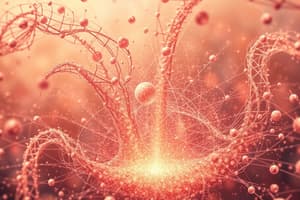Podcast
Questions and Answers
Head to www.savemyexams.com for more awesome ______
Head to www.savemyexams.com for more awesome ______
resources
Page ______ of 10
Page ______ of 10
1
Revision Notes, Topic Questions, Past ______
Revision Notes, Topic Questions, Past ______
Papers
The content is from Save My ______ for educational use.
The content is from Save My ______ for educational use.
The material encompasses various topics for ______ preparation.
The material encompasses various topics for ______ preparation.
You can find more awesome resources at ______
You can find more awesome resources at ______
This document contains ______ pages in total.
This document contains ______ pages in total.
Flashcards
Chemical Substance
Chemical Substance
A chemical substance that can be combined with other substances by chemical reactions to produce new substances.
Compound
Compound
A substance that can be separated into simpler substances by chemical means.
Element
Element
A pure substance that cannot be broken down into simpler substances by chemical means.
Homogeneous mixture
Homogeneous mixture
Signup and view all the flashcards
Heterogeneous mixture
Heterogeneous mixture
Signup and view all the flashcards
Pure substance
Pure substance
Signup and view all the flashcards
Distillation
Distillation
Signup and view all the flashcards
Filtration
Filtration
Signup and view all the flashcards
Study Notes
Kinetic Theory of Matter
- Solids have a fixed shape and volume, and high density
- Atoms vibrate, but cannot change location
- Particles are closely packed in a fixed, regular pattern
Kinetic Theory of Liquids
- Liquids have a fixed volume but take the shape of their container
- Liquids are generally less dense than solids, but more dense than gases
- Particles move and slide past each other, allowing them to flow
Kinetic Theory of Gases
- Gases have no fixed volume and take the shape of their container
- Gases have a very low density
- Particles are far apart, and move randomly at high speed (around 500 m/s) in all directions
- Particles collide with each other and container walls, creating pressure
Summary of Solid, Liquid, and Gas Properties
| Property | Solid | Liquid | Gas |
|---|---|---|---|
| Density | High | Medium | Low |
| Particle Arrangement | Regular | Random | Random |
| Particle Movement | Vibrate around fixed positions | Move around each other | Move quickly in all directions |
| Particle Energy | Low | Greater | Highest |
States of Matter and State Changes
-
Melting: Solid to liquid; requires heat energy; occurs at a specific temperature (melting point)
-
Boiling: Liquid to gas; requires heat energy; occurs at a specific temperature (boiling point)
-
Freezing: Liquid to solid; reverse of melting; occurs at the same temperature (melting point)
-
Evaporation: Liquid to gas; occurs at the surface of liquids over a temperature range; below the boiling point.
-
Condensation: Gas to liquid; cooling a gas causes particles to lose energy and group together, forming a liquid; occurs over a temperature range.
-
Sublimation: Solid to gas; few solids undergo this; like iodine or solid carbon dioxide. The reverse reaction is desublimation / deposition.
Pressure and Temperature in Gases
- Changes in temperature and pressure affect the volume of gases
- As gas temperature increases, the gas volume increases; the density decreases
- If a gas's container is compressed (volume is decreased), its pressure increases
- Gas particles are in constant, random motion
- Pressure is created by particles colliding with the inside walls of a container.
Heating and Cooling Curves
- As substances are heated, kinetic energy increases, causing particles to vibrate more rapidly
- Changes in state are shown by horizontal sections in a heating curve, where temperature remains constant
- Cooling curves are the mirror image of heating curves, showing temperature decrease corresponding to phase changes.
Studying That Suits You
Use AI to generate personalized quizzes and flashcards to suit your learning preferences.




